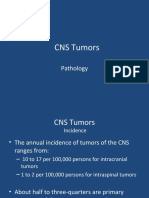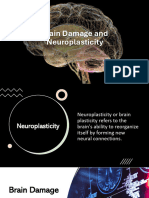0 ratings0% found this document useful (0 votes)
37 viewsMeningomyelocele (Spina Bifida) : Bony Neural Arch Not Completely Closed
Meningomyelocele (Spina Bifida) : Bony Neural Arch Not Completely Closed
Uploaded by
lindelle elijahThe document discusses several congenital and hereditary diseases, inflammatory/infectious diseases, degenerative diseases, vascular diseases, and neoplastic diseases of the central nervous system. Specifically, it describes meningomyelocele (spina bifida), hydrocephalus, meningitis, encephalitis, brain abscess, degenerative disk disease, cervical spondylosis, multiple sclerosis, strokes (ischemic and hemorrhagic), and several types of brain tumors - gliomas, oligodendroglioma, ependymoma, medulloblastoma, meningioma, pituitary adenoma, and craniopharyngioma. It provides details on symptoms, causes,
Copyright:
© All Rights Reserved
Available Formats
Download as PPTX, PDF, TXT or read online from Scribd
Meningomyelocele (Spina Bifida) : Bony Neural Arch Not Completely Closed
Meningomyelocele (Spina Bifida) : Bony Neural Arch Not Completely Closed
Uploaded by
lindelle elijah0 ratings0% found this document useful (0 votes)
37 views33 pagesThe document discusses several congenital and hereditary diseases, inflammatory/infectious diseases, degenerative diseases, vascular diseases, and neoplastic diseases of the central nervous system. Specifically, it describes meningomyelocele (spina bifida), hydrocephalus, meningitis, encephalitis, brain abscess, degenerative disk disease, cervical spondylosis, multiple sclerosis, strokes (ischemic and hemorrhagic), and several types of brain tumors - gliomas, oligodendroglioma, ependymoma, medulloblastoma, meningioma, pituitary adenoma, and craniopharyngioma. It provides details on symptoms, causes,
Original Title
CNS PATHO
Copyright
© © All Rights Reserved
Available Formats
PPTX, PDF, TXT or read online from Scribd
Share this document
Did you find this document useful?
Is this content inappropriate?
The document discusses several congenital and hereditary diseases, inflammatory/infectious diseases, degenerative diseases, vascular diseases, and neoplastic diseases of the central nervous system. Specifically, it describes meningomyelocele (spina bifida), hydrocephalus, meningitis, encephalitis, brain abscess, degenerative disk disease, cervical spondylosis, multiple sclerosis, strokes (ischemic and hemorrhagic), and several types of brain tumors - gliomas, oligodendroglioma, ependymoma, medulloblastoma, meningioma, pituitary adenoma, and craniopharyngioma. It provides details on symptoms, causes,
Copyright:
© All Rights Reserved
Available Formats
Download as PPTX, PDF, TXT or read online from Scribd
Download as pptx, pdf, or txt
0 ratings0% found this document useful (0 votes)
37 views33 pagesMeningomyelocele (Spina Bifida) : Bony Neural Arch Not Completely Closed
Meningomyelocele (Spina Bifida) : Bony Neural Arch Not Completely Closed
Uploaded by
lindelle elijahThe document discusses several congenital and hereditary diseases, inflammatory/infectious diseases, degenerative diseases, vascular diseases, and neoplastic diseases of the central nervous system. Specifically, it describes meningomyelocele (spina bifida), hydrocephalus, meningitis, encephalitis, brain abscess, degenerative disk disease, cervical spondylosis, multiple sclerosis, strokes (ischemic and hemorrhagic), and several types of brain tumors - gliomas, oligodendroglioma, ependymoma, medulloblastoma, meningioma, pituitary adenoma, and craniopharyngioma. It provides details on symptoms, causes,
Copyright:
© All Rights Reserved
Available Formats
Download as PPTX, PDF, TXT or read online from Scribd
Download as pptx, pdf, or txt
You are on page 1of 33
CONGENITAL AND HEREDITARY DISEASES
Meningomyelocele (Spina Bifida)
-is a condition in which the bony neural arch that
encloses and protects the spinal cord is not completely
closed. It most commonly occurs in the lumbar region,
and the spinal cord and its meninges may or may not
herniate through the resultant opening.
Complications depend on the extent of protrusion and
range from treatable to life threatening. Any opening of
the sac to the exterior of the body risks meningeal
infection, so surgical closure is critical.
If only the meninges protrude, the condition is termed a
meningocele. A myelocele is a protrusion of the spinal cord,
minus its meningeal coverings, which may also be treatable
surgically. A meningomyelocele is the most common and
most serious of possible conditions, affecting approximately
one in every 800 infants and consisting of a protrusion of
both the meninges and the spinal cord into the skin of the
back.
Hydrocephalus
-refers to an excessive accumulation of CSF within the
ventricles and can be either congenital or acquired.
-This normal circulation may be interrupted by causes
such as an obstruction to flow (noncommunicating
hydrocephalus) and impaired absorption
(communicating hydrocephalus)
In noncommunicating hydrocephalus, an obstruction
may occur congenitally or result from tumor growth,
trauma (hemorrhage), or inflammation. It interferes
with or blocks normal CSF circulation from the ventricles
to the subarachnoid space.
In communicating hydrocephalus, Poor reabsorption of
CSF by arachnoid villi results. It
may arise from a number of factors, including increased
ICP caused by tumor compression, raised intrathoracic
pressure impairing venous drainage, inflammation from
meningitis, or subarachnoid hemorrhage.
INFLAMMATORY AND INFECTIOUS DISEASES
Meningitis
-An inflammation of the meningeal coverings of the
brain and spinal cord is termed meningitis.
-It may be caused by bacteria, viruses, or other
organisms that reach the meninges from elsewhere
in the body via blood or lymph or may occur as a
result of trauma and penetrating wounds or from
adjacent structures (e.g., the mastoids) that
become infected.
- Bacterial infection is the most common cause of
meningitis.
Encephalitis
-An infection of the brain tissue
is termed encephalitis. In
contrast to meningitis, which is
most frequently a bacterial
infection, encephalitis is usually
viral in nature and may also
occur subsequent to conditions
such as chickenpox, smallpox,
influenza, and measles.
-This condition is more serious
than meningitis because
individuals who acquire
encephalitis more frequently
develop permanent neurologic
Brain Abscess
-A brain abscess is an
encapsulated accumulation of pus
within the cranium resulting from
a cranial infection, a penetrating
head wound, or an infection
spread through the bloodstream.
-A brain abscess may also result
from the direct spread of
organisms associated with a
complicated case of sinusitis,
chronic otitis, or mastoiditis.
-Brain abscesses are fatal unless
they are treated with antibiotic
therapy.
DEGENERATIVE DISEASES
Degenerative Disk Disease and Herniated Nucleus
Pulposus
-A herniated nucleus pulposus, or herniated disk, may result
from either degenerative disease or trauma.
-A weakened or torn annulus fibrosus is subject to rupture,
which allows the nucleus pulposus to protrude and compress
spinal nerve roots.
Cervical Spondylosis Osteoarthritic
-conditions may also affect the vertebral column, leading
to nerve disorders caused by chronic nerve root
compression.
-These osteoarthritic changes of the neck are referred to
ascervical spondylosis and are well demonstrated
radiographically, most notably on an oblique projection
of the cervical spine.
-Osteophytes (bone spurs) form in the articular facets of
the cervical vertebrae and compress the nerves located
in the intervertebral foramina. They may also compress
the spinal cord.
Multiple Sclerosis
MS, a chronic, progressive disease
of the nervous system. The etiology
of this disease is unknown, but
research indicates that it may result
from a latent herpesvirus or
retrovirus infection.
-MS involves degeneration of the
myelin sheath covering the nervous
tissue of the spinal cord and the
white matter within the brain. This
demyelination impairs nerve
conduction, beginning with muscle
impairment and loss of balance and
coordination.
VASCULAR DISEASES
Cerebrovascular Accident
Atherosclerotic disease affecting the
blood supply to the brain may
eventually result in a cerebrovascular
accident (CVA), commonly referred to as
a stroke.
Strokes occur in essentially two ways,
and they are classified as ischemic
and hemorrhagic.
Ischemic strokes are caused when a
blood clot blocks a blood vessel in the
brain. In contrast, hemorrhagic
strokes, occur when a blood vessel in
the brain ruptures and bleeds into
the adjacent brain tissues and
Ischemic Strokes
In an ischemic stroke, however, blood clots are
dangerous because they may block blood flow and
cause vessel occlusion. An ischemic stroke may occur in
two ways:
(1) infarction caused by thrombosis of a cerebral artery
or
(2) embolism to the brain from a thrombus elsewhere in
the body. A thrombus is a blood clot that obstructs a
blood vessel, and an embolus is a mass of undissolved
matter (solid, liquid, or gas) present in a blood vessel
brought there by blood current.
Hemorrhagic Strokes
In a hemorrhagic stroke, brain hemorrhage results
from a weakening in the diseased vessel wall. Typically,
the ruptured vessel has been weakened by
arteriosclerosis from hypertension; however,
hemorrhage may also result from
congenital aneurysms or vascular anomalies.
The onset of this type of CVA is sudden and often
lethal because it expands rapidly. Brain hemorrhages
account for approximately 10% to 15% of all CVAs and
are of two types: (1) subarachnoid and (2)
intracerebral.
NEOPLASTIC DISEASES
In many cases, the location of the brain neoplasm is of equal
or greater importance than its malignancy or benignancy
because of the complications produced by mass effect.
Primary brain tumors may be classified according to the site
such as the specific lobe of the brain or according to
histologic composition. The two categories of brain tumors
based on histologic type are glial and nonglial neoplasms.
Glial tumors generate from the supporting tissues of the
brain and spinal cord. Gliomas account for about half of all
primary brain tumors. Their growth occurs through
infiltration, making them difficult to treat surgically through
resection. Nonglial tumors grow through expansion and are
more treatable surgically. Meningiomas are the most
frequently occurring nonglial tumors.
Gliomas
The most common type of primary brain tumor is
the glioma accounting for approximately 45% of all
intracranial tumors.
Gliomas commonly occur in the cerebral hemispheres
and the posterior fossa, with nearly half of all gliomas
classified as the malignant glioblastoma variety.
Other types of gliomas include benign astrocytomas,
oligodendrogliomas, and ependymomas. In terms of
MRI results, gliomas are evaluated on the basis of
associated edema, mass effect, and amount of contrast
enhancement.
Astrocytomas account for about a third of all gliomas and are
composed of astrocytes, which are star-shaped neuroglial
cells with many branching processes. Astrocytomas are white,
usually slow-growing, infiltrative tumors with a low grade of
malignancy.
A glioblastoma multiforme (an advanced astrocytoma) is
highly malignant. Early detection leads to a good prognosis.
Oligodendroglioma
-is a slow-growing astrocytic
tumor, and histologically, it is
often relatively benign. It
typically calcifies so that its
appearance in a punctate or
stippled pattern on a skull
radiograph is virtually
diagnostic.
Ependymoma
-is a firm, whitish tumor that arises from the ependyma,
the lining of the ventricles .Typically, it derives from the
roof of the fourth ventricle, but it may also appear from
the central canal of the spinal cord.
Medulloblastoma
-Like astrocytic tumors, medulloblastomas are soft,
infiltrating tumors of neuroepithelial tissue. These
rapidly growing tumors are highly malignant and most
often occur in the cerebellum of children and young
adults and usually extend from the roof of the fourth
ventricle.
-In addition, tumor dissemination throughout the
subarachnoid space often blocks the flow of CSF, causing
hydrocephalus.
-Surgical excision of the tumor as much as possible and
radiation to the entire CNS (brain and spinal cord) have
improved the 5-year survival rate to over 50% and the
10-year survival rate to about 40%.
Meningioma is a slow-growing, generally benign tumor
that originates in the arachnoid tissue. It is the most
common nonglial tumor, accounting for about 15% of all
intracranial tumors.
-CT studies of patients with a diagnosis of meningioma
demonstrate a well-defined mass of increased attenuation.
Pituitary Adenoma
A pituitary adenoma is usually a benign tumor of the
pituitary gland, and these tumors comprise about
15% of all intracranial tumors.
Hormones produced by the pituitary are affected,
with one type of adenoma of the anterior pituitary
resulting in gigantism if it develops before puberty
and acromegaly if it occurs in adults because of
excessive production of growth hormone (GH).
Craniopharyngioma- is a cystic, benign tumor growing
from remnants of the development of the pituitary gland. It
is thought to be developmental in origin and most
commonly manifests in childhood. Craniopharyngiomas
usually arise above the sella and extend upward into the
third ventricle. Occasionally, they are seen within the sella,
causing erosion of the sella turcica.
You might also like
- CNS TumorDocument32 pagesCNS TumorBbem ooNo ratings yet
- SDL 8 Intracranial Space Occupying LesionDocument5 pagesSDL 8 Intracranial Space Occupying LesionJonathan YeohNo ratings yet
- Intramedullary Spinal Cord TumorsDocument7 pagesIntramedullary Spinal Cord TumorsmutalimNo ratings yet
- Seminar On Brain TumorDocument26 pagesSeminar On Brain TumorawasthiphothocopyNo ratings yet
- Brain TumoursDocument45 pagesBrain TumoursChippy SinghNo ratings yet
- Brain AbscessDocument61 pagesBrain Abscessderarataye6No ratings yet
- Brain CancerDocument24 pagesBrain CancerJohn Lester FernandezNo ratings yet
- Tumors of The Nervous SystemDocument6 pagesTumors of The Nervous SystemRituNo ratings yet
- طب باطني (نظري) م8Document4 pagesطب باطني (نظري) م8asalla.fayyad.rdNo ratings yet
- BioPsychology: Brain DamageDocument45 pagesBioPsychology: Brain DamageajieNo ratings yet
- Brain TumorDocument9 pagesBrain TumorSara SabirNo ratings yet
- BRAIN TUMOR-Online Learning 1Document11 pagesBRAIN TUMOR-Online Learning 1エルミタ ジョイ ファティマNo ratings yet
- 2 Brain AbscessDocument25 pages2 Brain AbscessKaif KhanNo ratings yet
- PR Dr. AriadneDocument8 pagesPR Dr. AriadneSofia KusumadewiNo ratings yet
- Causes of Brain DamageDocument2 pagesCauses of Brain Damagejanlyn espinosaNo ratings yet
- Brain TumorsDocument72 pagesBrain Tumorsmo_mibNo ratings yet
- Brain Tumor ICP Head and Neck CA TracheostomyDocument11 pagesBrain Tumor ICP Head and Neck CA TracheostomyWincy Faith SalazarNo ratings yet
- Brain TumorsDocument34 pagesBrain TumorsbenedictusNo ratings yet
- Absceso Cerebral 99Document7 pagesAbsceso Cerebral 99shen_siiNo ratings yet
- Mandatory at First Presentation With: Meningitis, in An Obviously IllDocument13 pagesMandatory at First Presentation With: Meningitis, in An Obviously IllkughaprianNo ratings yet
- Absceso CerebralDocument8 pagesAbsceso Cerebralgiseladelarosa2006No ratings yet
- Levin ch06 p171-192 PDFDocument22 pagesLevin ch06 p171-192 PDFCyntiaNo ratings yet
- 2 5291964174748882717Document11 pages2 5291964174748882717نشط عقلكNo ratings yet
- Brain TumorDocument26 pagesBrain TumorreginNo ratings yet
- Brain TumorDocument67 pagesBrain TumorNur AgamiNo ratings yet
- Brain Tumor: Classification and External ResourcesDocument5 pagesBrain Tumor: Classification and External ResourcestheamaciasNo ratings yet
- Head InjuryDocument6 pagesHead InjuryHurrinazilla AwaliaNo ratings yet
- Tumors of Auditory Nervous SystemDocument43 pagesTumors of Auditory Nervous SystemgitengeorgeNo ratings yet
- Week 5 Craniotomy Part IDocument26 pagesWeek 5 Craniotomy Part Ikatherinerance331No ratings yet
- Brain Abscess and SepsisDocument32 pagesBrain Abscess and SepsisSanjeet SahNo ratings yet
- LP Brain TumorDocument20 pagesLP Brain TumorMuhammad PanduNo ratings yet
- Brain & S. C. Tumors, Aneurysm, AVM, Trigeminal Neuralgia, Bell's PalsyDocument15 pagesBrain & S. C. Tumors, Aneurysm, AVM, Trigeminal Neuralgia, Bell's PalsypertinenteNo ratings yet
- Brain Tumors: Primary BTDocument5 pagesBrain Tumors: Primary BTMohamed Al-zichrawyNo ratings yet
- Medulloblastoma Is A Cancerous1Document4 pagesMedulloblastoma Is A Cancerous1Iskabetseng IsdaNo ratings yet
- Brain TumorDocument26 pagesBrain TumorVikas SinghNo ratings yet
- Pathology of The Central Nervous SystemDocument78 pagesPathology of The Central Nervous Systemعلي عليNo ratings yet
- Abses CerebriDocument3 pagesAbses CerebriMohammadAwitNo ratings yet
- Tuberculous MeningitisDocument14 pagesTuberculous Meningitiskuchaibaru90No ratings yet
- LECTURE SIX - Pathology of Nervous, EyeDocument14 pagesLECTURE SIX - Pathology of Nervous, EyelockairtimeservicesNo ratings yet
- Brain CancerDocument29 pagesBrain CancerMaria VisitacionNo ratings yet
- D17B PresentationDocument28 pagesD17B PresentationBruno KandatamNo ratings yet
- Brain Damage and NeuroplasticityDocument25 pagesBrain Damage and NeuroplasticitykatNo ratings yet
- Brain TumorsDocument19 pagesBrain TumorsNavjot BrarNo ratings yet
- Brain Tumours: Clinical FeaturesDocument3 pagesBrain Tumours: Clinical FeaturesOber Sánchez100% (1)
- Pathology NeurologyDocument2 pagesPathology Neurologybaghuashvili1011No ratings yet
- Spinal Cord Lesions 1Document43 pagesSpinal Cord Lesions 1Worthless Boys100% (4)
- Intramedullary Spinal Cord Tumors: Clinical PresentationDocument15 pagesIntramedullary Spinal Cord Tumors: Clinical Presentationmetasoniko81No ratings yet
- The Radiology Assistant Brain Tumor - Systematic Approach PDFDocument29 pagesThe Radiology Assistant Brain Tumor - Systematic Approach PDFMichael DeanNo ratings yet
- A Meningioma Is ADocument20 pagesA Meningioma Is ASherry KingNo ratings yet
- Sol IntracranialDocument76 pagesSol IntracranialPanduRespatiNo ratings yet
- Tumors of The Brain Stem, Cerebellum, and Fourth VentricleDocument22 pagesTumors of The Brain Stem, Cerebellum, and Fourth VentricleArjun RaNo ratings yet
- PRAKTIKUM Neuropatologi 2015-2Document11 pagesPRAKTIKUM Neuropatologi 2015-2Frisca Zulia NandaNo ratings yet
- Brainstem and Cerebellum Lesions in Adults: Pearls To The Diagnosis With MRIDocument48 pagesBrainstem and Cerebellum Lesions in Adults: Pearls To The Diagnosis With MRIradiologirsckNo ratings yet
- Pathophysiology: Gliomas Meningiomas Pituitary Adenomas Acoustic NeuromasDocument7 pagesPathophysiology: Gliomas Meningiomas Pituitary Adenomas Acoustic NeuromasWira Febrisandi IrsanNo ratings yet
- Neuropathology: FK UisuDocument28 pagesNeuropathology: FK UisuAnggi WahyuNo ratings yet
- MENINGIOMAS AND GLIOMAS.Document17 pagesMENINGIOMAS AND GLIOMAS.AshlyNo ratings yet
- Cerebral AneurysmDocument6 pagesCerebral AneurysmNavjot BrarNo ratings yet
- Brain Tumor Increased Icp Head Neck Ca and Tracheostomy VillamorDocument24 pagesBrain Tumor Increased Icp Head Neck Ca and Tracheostomy Villamorchristian pulmonesNo ratings yet
- Brain AbscessDocument13 pagesBrain Abscesskashim123No ratings yet
- Atlas of Clinical Cases on Brain Tumor ImagingFrom EverandAtlas of Clinical Cases on Brain Tumor ImagingYelda ÖzsunarNo ratings yet
- NeuroDocument12 pagesNeuroRiza MarquezNo ratings yet
- Clinical GuidlinesDocument200 pagesClinical GuidlinesMujtaba NadeemNo ratings yet
- Isaacs2002Document13 pagesIsaacs2002FarhanNo ratings yet
- Abstracts of The 2018 AANS/CNS Joint Section On Disorders of The Spine and Peripheral Nerves Annual MeetingDocument109 pagesAbstracts of The 2018 AANS/CNS Joint Section On Disorders of The Spine and Peripheral Nerves Annual MeetingEka Wahyu HerdiyantiNo ratings yet
- Comparative Evaluation For Detection of Brain Tumor Using Machine Learning AlgorithmsDocument9 pagesComparative Evaluation For Detection of Brain Tumor Using Machine Learning AlgorithmsIAES IJAINo ratings yet
- Intraoperative CytologyDocument86 pagesIntraoperative Cytologypreeti sharmaNo ratings yet
- Brain Tumor-1Document56 pagesBrain Tumor-1Sadab AlamNo ratings yet
- Neurology NotesDocument87 pagesNeurology Notessuggaplum100% (2)
- Clinical Trials in BrainDocument16 pagesClinical Trials in Brainmadhukar1978No ratings yet
- Head NeckDocument254 pagesHead Neckdrsajal100% (1)
- CNS TumorsDocument32 pagesCNS TumorsjaveriaNo ratings yet
- Supratentorial TumorsDocument13 pagesSupratentorial TumorsRavi Kumar Singhal100% (1)
- 3book ChaptersupratentorialbraintumorsinchildrenDocument13 pages3book ChaptersupratentorialbraintumorsinchildrenLuciano AlvesNo ratings yet
- WHO Classification of Tumors of The Nervous System: Preview of The Upcoming 5th EditionDocument4 pagesWHO Classification of Tumors of The Nervous System: Preview of The Upcoming 5th EditionMiaNo ratings yet
- CNS Tumors NeurologyDocument45 pagesCNS Tumors NeurologyChristinaNo ratings yet
- Mandatory at First Presentation With: Meningitis, in An Obviously IllDocument13 pagesMandatory at First Presentation With: Meningitis, in An Obviously IllkughaprianNo ratings yet
- The 2021 WHO Classification of Tumors of The Central Nervous System, A SumaryDocument21 pagesThe 2021 WHO Classification of Tumors of The Central Nervous System, A SumaryDTNo ratings yet
- Glioma in Adults - Beyond The Basics (High-Grade)Document9 pagesGlioma in Adults - Beyond The Basics (High-Grade)Hugh Ell - auNo ratings yet
- Tumors of Nervous SystemDocument50 pagesTumors of Nervous SystemNininghrNo ratings yet
- Brain Tumours (Primary) - NICE Guide 2021Document69 pagesBrain Tumours (Primary) - NICE Guide 2021DrHellenNo ratings yet
- Squash CytologyDocument66 pagesSquash CytologyMarvi UmairNo ratings yet
- cIMPACT-NOW Update 2 Diagnostic Clarifications For Diffuse Midline Glioma, H3 K27M-mutant and Diffuse Astrocytomaanaplastic Astrocytoma, IDH-mutantDocument4 pagescIMPACT-NOW Update 2 Diagnostic Clarifications For Diffuse Midline Glioma, H3 K27M-mutant and Diffuse Astrocytomaanaplastic Astrocytoma, IDH-mutantDTNo ratings yet
- Cns PathologyDocument18 pagesCns Pathologysunnyorange8No ratings yet
- Neurorehabilitation in Neuro-Oncology 2019 E-BookDocument254 pagesNeurorehabilitation in Neuro-Oncology 2019 E-BookWoffe SoloNo ratings yet
- A.K12 - FINAL Management Brain Tumors Dr. Dr. Rr. Suzy Indharty, M. Kes, SP - BsDocument42 pagesA.K12 - FINAL Management Brain Tumors Dr. Dr. Rr. Suzy Indharty, M. Kes, SP - BsandrianyNo ratings yet
- Classification of Brain Tumours in MR Images Using Deep Spatiospatial ModelsDocument11 pagesClassification of Brain Tumours in MR Images Using Deep Spatiospatial ModelsMessage Of peaceNo ratings yet
- 5 4b Childhood Malignancy Part 2 DR Melanie Victoria G DarDocument7 pages5 4b Childhood Malignancy Part 2 DR Melanie Victoria G DarSamatha SamathaNo ratings yet
- Atlas of PET CT in Oncology - Volume 1 Brain Head and Neck Cancers Yao 1 Ed 2023Document322 pagesAtlas of PET CT in Oncology - Volume 1 Brain Head and Neck Cancers Yao 1 Ed 2023martinus.urbanusNo ratings yet
- Imaging in Brain TumorDocument142 pagesImaging in Brain TumorMagrinov AzaniaNo ratings yet
























































































